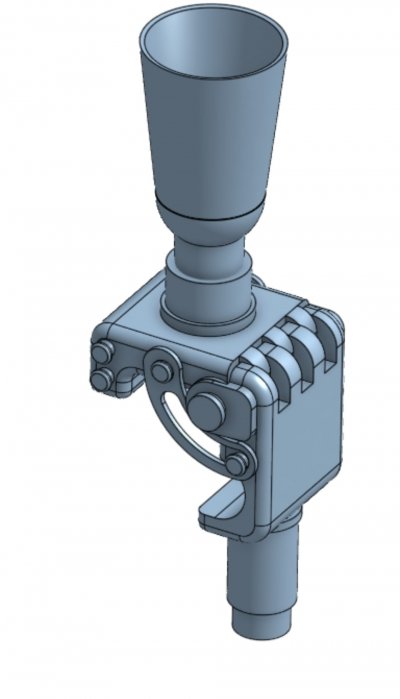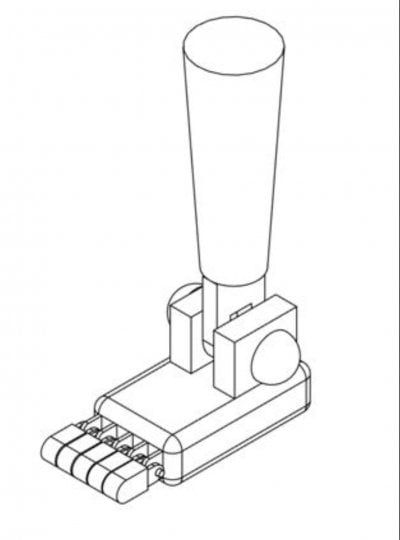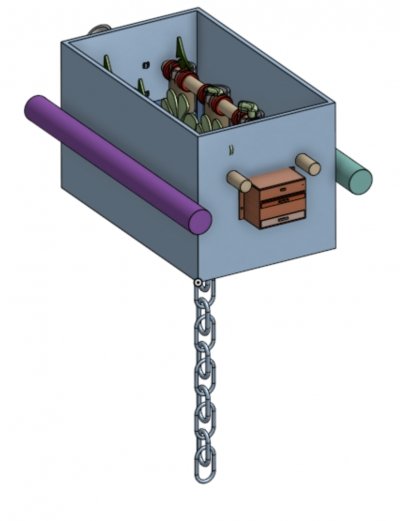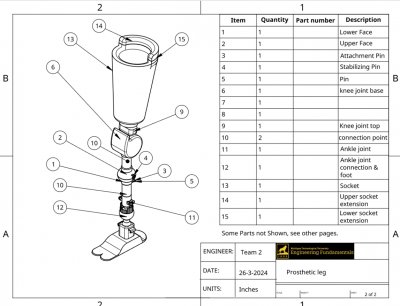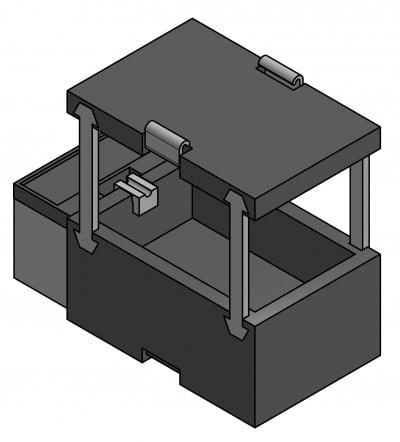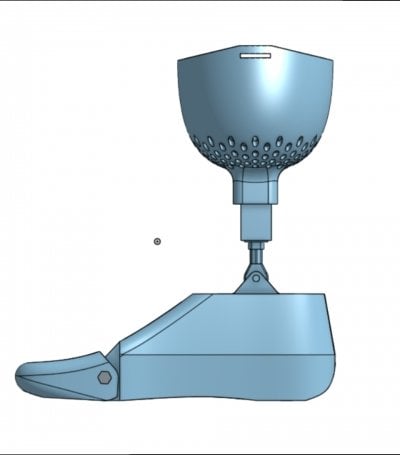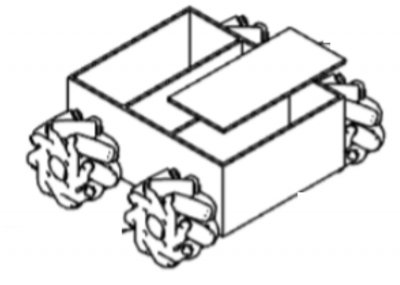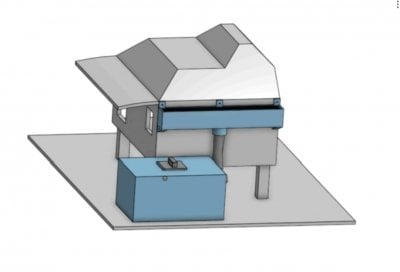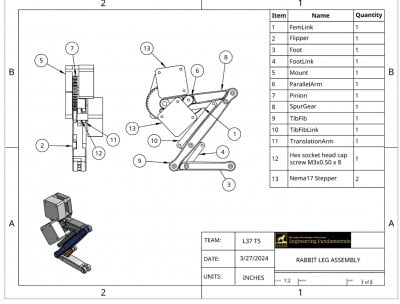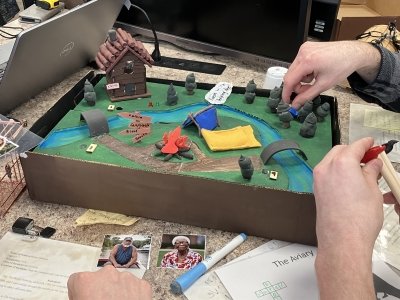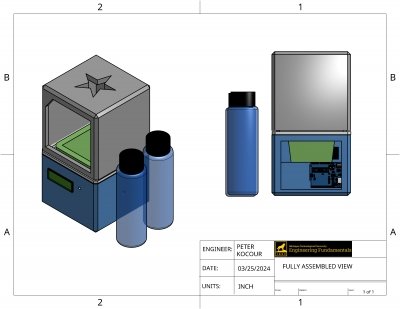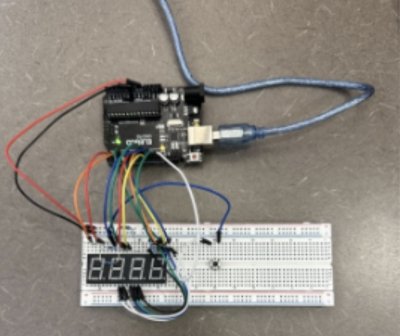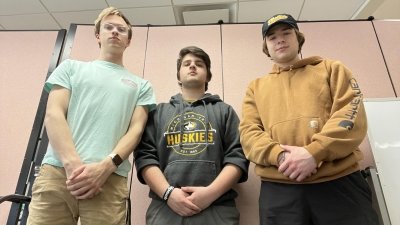401. Above-the-Knee Kneeling Prosthetic for Blue-Collar Workers
Project Description: This project is focused on the development of a prosthetic designed to specifically target blue collar workers who need to bend their knees, use the side to side motion of the knee, and need stability with kneeling. The project includes a 3D virtual model as well as a physical prototype that articulates via Matlab and sensors integrated using an Arduino.
402. AridEden: Cultivating Life in Barren Lands
Project Description: The goal of the AirEden is to develop a product that is capable of growing plants in barren lands such as a desert. Our growing pods will be powered by a solar panel so they will not need to be connected to the grid. It will also have a water reservoir that will be used to water the plant whenever the moisture levels in the soil drop to a certain level.
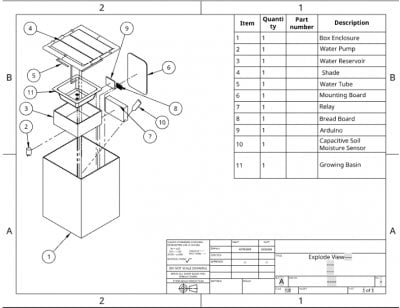
404. Below the Knee Prosthetic Attachment for Youth
Project Description: This project focuses on the development of a below-the-knee leg prosthesis prototype for child amputees. Ultimately, the goal is to create a comfortable, accessible, durable, and safe product. In addition to a 3D virtual model, the project uses an Arduino, 3D-printed parts, and MATLAB to create a physical model that simulates motion by flexing the prosthetic device at the ankle and toes.
407. Emotion and Empathy in Engineering: Haunted Mine Jump Scare
Project Description: The goal of the skeleton arm project is to construct a relatively inexpensive scare prop that the VPA at MTU will use in their Haunted Mine Tours. We hope to scare those going through the attraction by very quickly extending a skeleton arm from a fake pile of rocks. The project will be reviewed by VPA for practicality of use in the Haunted Mine Tours.
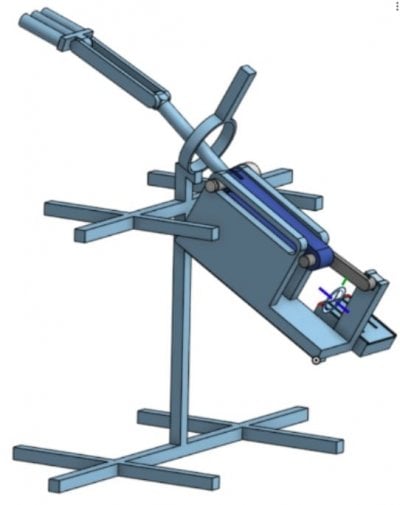
Early Design concept of frame with arm and extender attached.
408. Emotion and Empathy in Engineering: Eyes in the Dark
Project Description: This project depicts a decapitated head with eyes that follow the tour group in the mines. The goal is to create a scary attraction that utilizes arduinos and matlab to enhance the tour group's experience in Quincy Mine. To turn the eyes we shave a 3D printed assembly that turns the eyes together via a stepper motor. The base contains most electronic components along with ultrasonic sensors which are used to track the group. The project provides some extra detail to the mine without distracting from other attractions.

409. Emotion and Empathy in Engineering: Haunted Mine Surprise Box
Project Description: The goal of the Real World Through Theater project is to create a theater prop for the haunted mine tour at the Quincy mine. The purpose of this project is to create a more spooky or scary environment for the mine tour around halloween. The state of the project is near completion. Each piece of the project is almost complete, final assembly is the last step. Among the parts are the arduino and circuit to control LED lights, the wooden crate made from recycled wood, and the 3d printed hand and stick of dynamite, which will light up when visitors get within close proximity to the box.
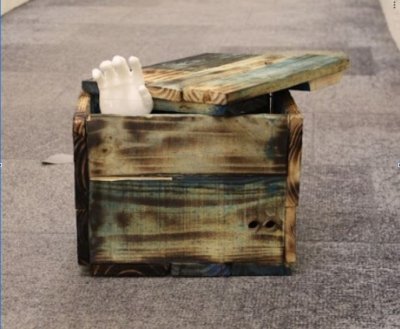
410. Emotion and Engineering: Haunted Cat
Project Description: The goal of the Visual and Performing Arts project was to design a prototype that utilized a sensor to randomly trigger a motorized response. The main purpose of this project was to design a model that could potentially be used in next year's haunted mine tours to help add to the viewer's experience. Currently, this project is in its second phase of development, as the team is working on developing a complete model and a code that enhances the design by adding randomized elements.
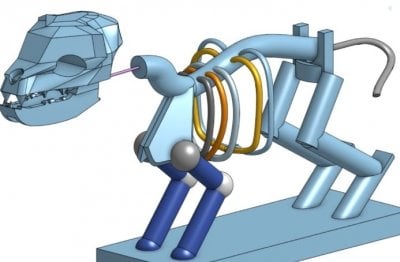
411. The Flood Buddy
Project Description: Populations living in high flood-risk areas struggle to reliably grow produce due to crop loss, contamination, soil erosion, equipment loss, debris deposition, and the spread of invasive species brought on by floods. By creating a product that can protect crops in these harsh natural disasters, the ability to preserve a food supply for communities can be achieved. The Flood-Buddy is a durable and eco-friendly solution that will allow plants to grow in high-flooding environments. The pod is designed to be able to withstand the moving water, and it can also filter the dirty flood water. This filtration will fill the water with nutrients promoting plant growth. The pod is made from recycled materials, and it is designed to be energy efficient.
412. Fully Articulated Human Prosthetic Leg
Project Description: Our prosthetic leg design prioritizes comfort, flexibility, and affordability. It mimics natural leg motion with a rigid structure, featuring a fluid-moving knee, linear ankle with slight side-to-side motion, and a spring-based foot for smooth gait. Constructed from lightweight carbon fiber for durability, the prototype will be modeled on ONSHAPE, detailing each component's dimensions and functions. A working assembly will demonstrate the final product's movement.
413. Hand Washing Station for Pu Ngaol Village, Cambodia
Project Description: The clients in question for this EWB project are the villagers of Pu Ngaol, Cambodia. Located in the poor Mondulkiri province, these villagers overcome immense adversity in their day-to-day lives that often go unnoticed. The needs of these villagers span from sanitation and hygiene needs and overall water accessibility to better infrastructure and waste management. The EWB brief details each of these needs in plenty, but a simple look at the village shows that the run-down roads, lack of easy clean water accessibility, and absence of toilets are concerning and infringe upon the villagers' quality of life. Our team wants to find a solution to the problem of disease transfer. We looked at how to attack this problem from many different angles but it mainly came down to how we could make hand washing more accessible.
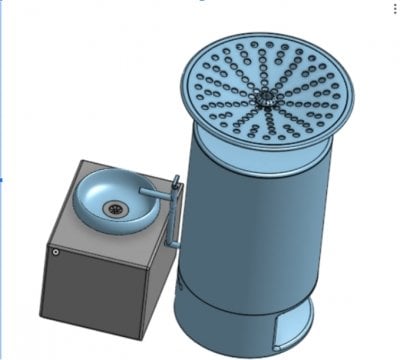
414. The Hummus Pod
Project Description: The Hummus Pod was designed with the intention of providing a sustainable and healthy solution to individuals within food deserts. To ensure optimal growing required the monitoring of of various different sensors such as moisture, light, air temperature, and light levels through the Arduino micro-controller. Furthermore, we continued to promote the health of the user through the optional "pedal generator" attachment which adds an additional to a healthy mindset, saving dollars on the energy bill.
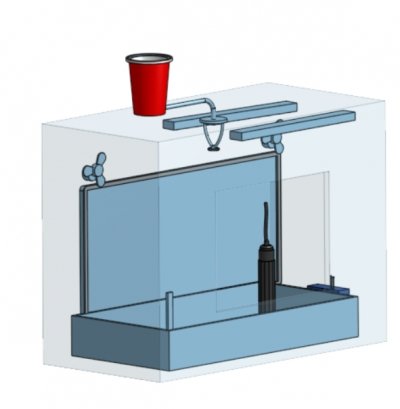
416. ModuGrow: Your Custom Indoor Garden
Project Description: We developed our ModuGrow project as an inexpensive plant growing pod for smaller, low light level spaces. Our pod features clips and interlocking pieces, allowing vertical stacking to fit any apartment space. The base for our pod is all 3D-printed components, making it more affordable and lightweight. The growing components fit inside the box and lid, conserving space. These components include grow lights with different coded light settings, an automated watering system, and an integrated timer system that controls the hours of light provided and watering times.
417. Modular Athletic Prosthetic Leg
Project Description: Our project is focused on the development of a prosthetic leg with multiple modular attachments that can be used for different purposes. These attachments will connect to an artificial limb and will be designed with accessibility and comfort in mind. Along with a 3D virtual model, we have developed a physical prototype that can be articulated using a MATLAB interface and sensors integrated via Arduino.
418. Modular Prosthetic Hand
Project Description: The goal of this modular prosthetic hand is to design a bionic limb that has fully functional fingers that can be controlled by an amputee. The project includes a 3D modeled arm that can be articulated using a sensor that measures electrical activity of the user's arm muscles. A printed prototype interfaces with MATLAB using Arduino-integrated sensors to simulate motion.
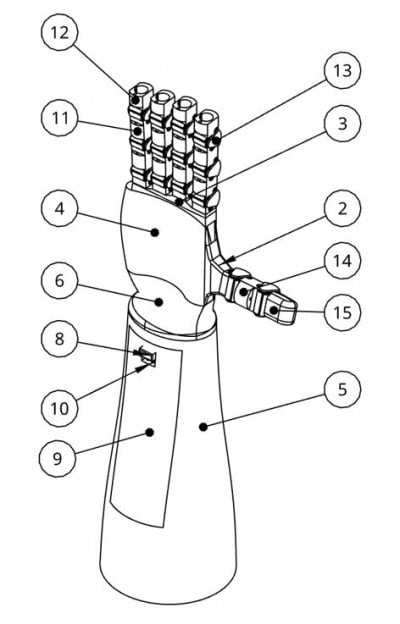
Modular Prosthetic Hand
419. Penguins of Madagascar: Escape the Zoo
Project Description: Escape the Zoo is the most engaging, creates a challenge for our semester project, and has the potential to be an efficient escape box. Escape the Zoo created a fun and engaging theme and the common knowledge of the Madagascar movies allows us to make movie references as puzzles. At the very beginning of our puzzle, users will be presented with a box with a laminated message on the top informing them that they, the penguins from Madagascar, need to break out of the Central Park Zoo to help The North Wind stop a nefarious plot against their home. For the puzzles incorporated in the theme, we thought of Morse code, lock and key, map puzzles, and many more.
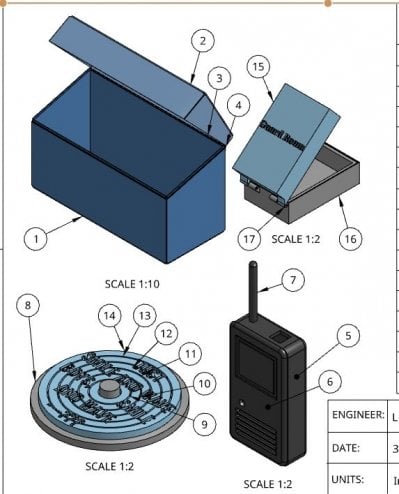
420. Pyramid Escape
Project Description: Our goal for this project is to teach students of a late high-school/early college age group pattern recognition and critical thinking skills through a 30-minute Arduino based escape box. Our theme is Ancient Egypt/archeology. Our box will have a pyramid façade and will open in sections revealing more puzzles and solutions.
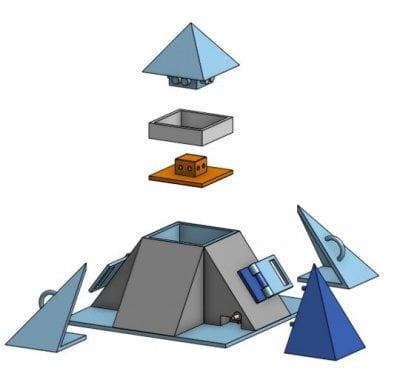
422. Robotic Paving
Project Description: The team's design consists of a car with containers of asphalt and sealer, sensors to monitor incoming objects and to detect road inconsistencies, and a roller on the back to smooth out the road afterwards.
423. Safe, Affordable Rainwater Collection and Storage for Pu Ngaol Village, Cambodia
Project Description: The goal of this design project is to meet the needs of the Pu Ngaol village members. The Pu Ngaol village is a small community in the Mondulkiri Province of Cambodia. Being a smaller village in Cambodia they have limited access to daily necessities like clean drinking water and sanitation. The project needs to be cost-effective since the project will be going into a community with very little money. The resources will be evaluated and questioned if there are enough resources to use in the community to build the project or if resources will have to be imported into the community.
424. Sensor Controlled Prosthetic Rabbit Leg
Project Description: This project showcases the kinematics of a rabbit's hip and leg, addressing mobility challenges due to injury, heart issues, or infections. Current prosthetic solutions fall short in providing full mobility, hindering rabbits from leading fulfilling lives. Our objective is to devise a more compassionate approach, enabling them to regain natural behaviors like hopping and jumping for a better quality of life.
425. The Aviary
Project Description: Our escape box is about a detective who is kidnapped and must find out who did it and all of the effects that come with it. We use games such as crosswords and mazes to work as a group. The participants will strengthen their knowledge in math terms, map reading, and quick solving through the escape box. Yet again, it will give a significant pressure that this is a team-bonding experience. High school students must learn to work and interact with others in a professional sense.
426. Ares Greenhouse: 3D-Printed Smart Grow Pods
Project Description: Develop a 3D printable, mass-deployable, and smart grow pod that can keep a plant in its ideal environment for growth in a Mars habitat without much human input. This is accomplished by designing a compact housing that is entirely 3D printable and uses off the self electronics to allow for just a 3D printer, filament, and electronics to be transported to another planet. This saves space which means several grow pods can be assembled on location and they don’t require a lot of space and as a result, money, to be flown over. In addition, this also allows for replacement parts, upgrades, or new models to be produced, again, without requiring a rocket to send over the new units.
427. Med Drop
Project Description: Our team prototyped an autonomous medical delivery devices to provide inexpensive last-mile solutions to life saving drugs for the mobility challenged members of society.
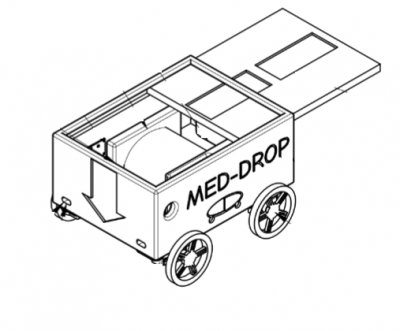
428. Sensor Project Application
Project Description: The project consists of creating a device that can collect, report, and analyze sensor data. With the use of our Arduino kits, we will collect students' experience on campus using a simple yes or no questionnaire. Using the buttons from the arduino kit and the 4-Digit 7-Segment Display, the arduino will keep count of the number of students that answer yes or no to the prompt, having them press the corresponded buttons to activate the display. the display will post the number of time each button is pressed. The goal is to set the device in a populated area, letting the arduino run the code throughout the day as students interact with the device. Two UNO R3 boards will be required to be able to run both of the displays at once.
429. Windmill Energy Visualization
Project Description: The goal of our Windmill Energy Visualization is to develop an efficient use of renewable energy, wind. The Windmill includes a 5V motor for the windmill blades, an array of LED lights, a Servo Motor, an analog stick, 3D printed parts, and paper blades. The main purpose of this project is to allow renewable energy to be in control of movement of a Servo motor. This is our final prototype.

